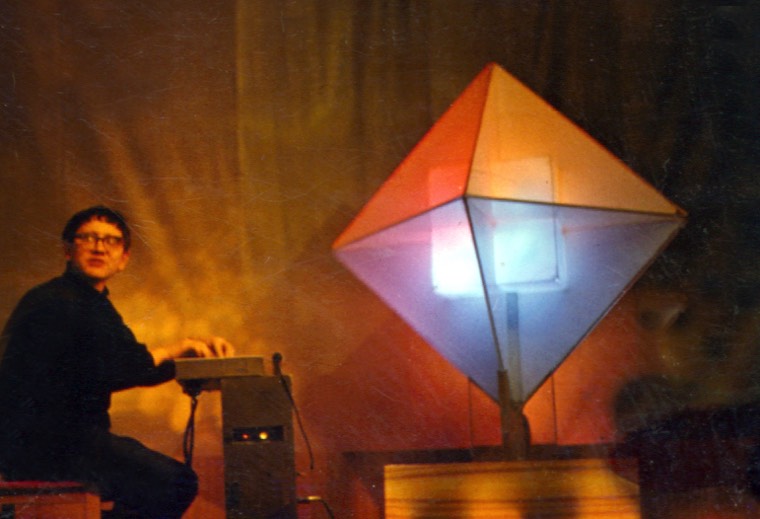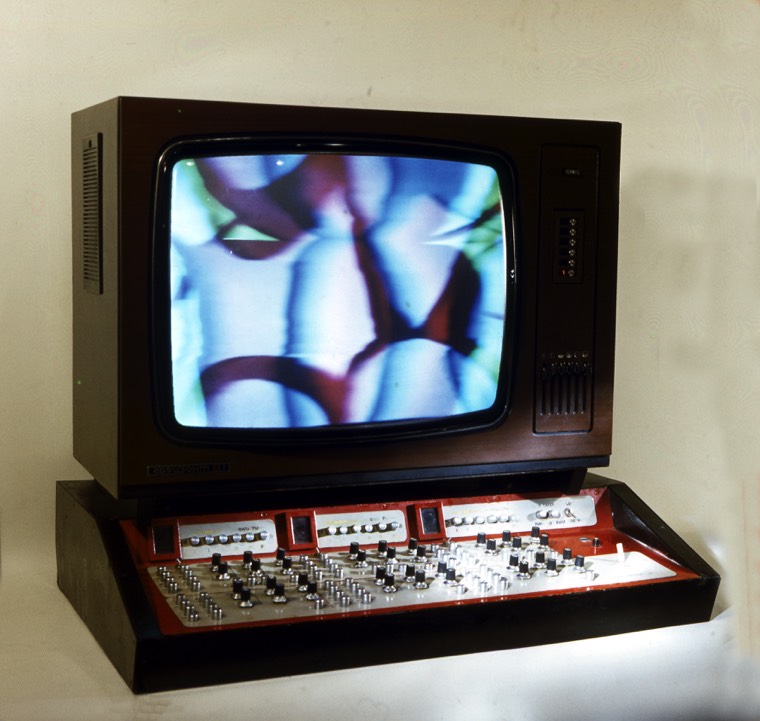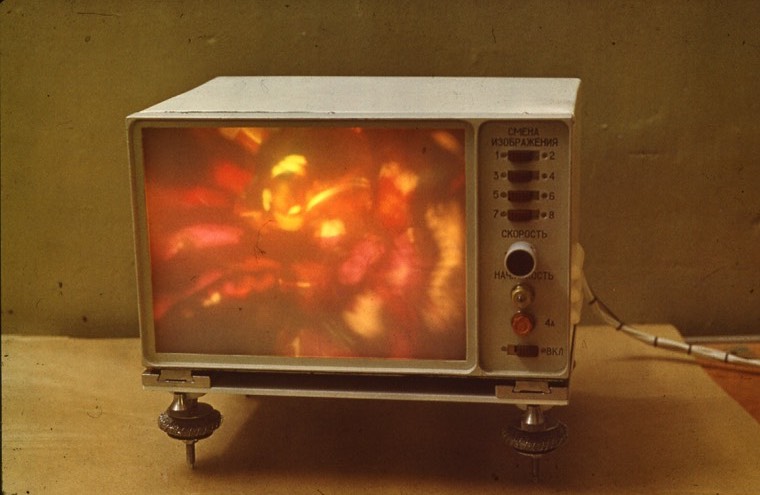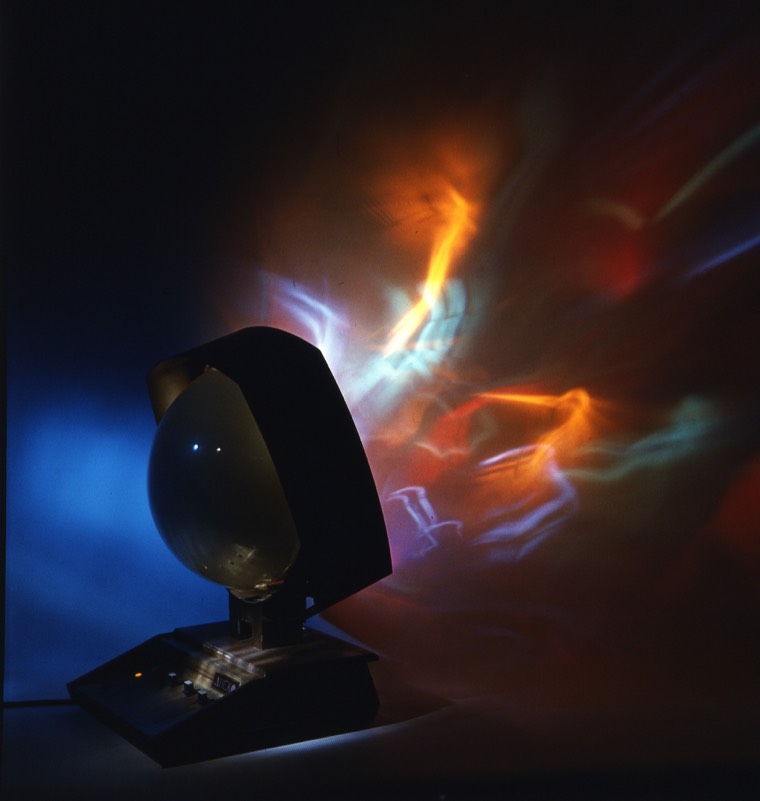

Into the Light: the story of the the Soviet media-art pioneer Bulat Galeev and his “Prometheus” Institute
Soviet unofficial art took cover not only in basements, dachas, and households, but, oddly enough, in governmental facilities, right under the nose of the authorities. That was the case with the visionary innovator of Russian video art, Bulat Galeev, and his brainchild, Kazan "Prometheus" Institute, known only to rare specialists until lately. Last year, Tatarian pioneers in synesthetic arts suddenly became sought-after. Firstly, performance in German Karlsruhe, and then an exhibition followed. It opened in a Moscow pop-up gallery "НИИ х Alpbau," ran by an architectural bureau Alpbau Struktura and a club "Science and Art," which bears a suitable name and attests an even more appropriate musical policy. "Inde" explains why "Prometheus" heritage is valuable, how were discotheque guides published by Kazan’s engineers, the Kremlin illuminated, and the light-organ for the New Russians constructed.
Construction Bureau ‘Prometheus’ Studio, 1972
The intentions of various art establishments to work with the "Prometheus" archive, exhibit an installation from the institution’s reserves, or publish a study on this subject are reasonable: experiments of Bulat Galeev and his team "Prometheus" were at the pinnacle of the modern art of the late '60s. His works are remembered as the earliest examples of media-art. "Prometheus" pioneered in every dimension of their work, which was unlikely for the Soviet Union: they pioneered in creating light organs, video installations, and, on an industrial scale, complicated lighting setups. Unlike other Soviet experimenters, for instance, Eugine Murzin, designer of the world’s first photoelectronic ANS synthуsizer, Galeev found the light of greater significance than sound. Galeev entered the international scene in the early '70s. Although the inventor barely had any chance to exhibit his works in galleries abroad or show them at film festivals, he kept in touch with famous western artists and composers. He corresponded with Nicolas Schöffer, Frank Molina, Iannis Xenakis, Léon Theremin, and Stelarc, — like-minded adepts of the symbiosis, in which modern technologies and artistic minds coexist.

Bulat Galeev’s audiovisual device ‘Crystal’
Abstraction
No one from "Prometheus" had any formal artistic training (Galeev per se was not admitted to an art school), so the team subscribed to their personal concept of beauty. According to Galeev, he fancied abstract pictures since early childhood, though he knew nothing of avant-gardists or, say, Kandinsky. The works of the former were prohibited in the Soviet Union for a long time. That didn't stop "Prometheans" from gradually gathering information on him: finding reproductions in albums and journals in available libraries or ordering them from abroad. Rustam Saifullin, a "Prometheus" veteran, can still recite the Lunachersky's review of Kandinsky’s works, where much of the "Prometheus" own logic was explained: "The music of coloration, a symphony of colors and linear melodies are perfectly comprehensible, especially infused with the music of sounds. But the dynamic is the foundation of music. To match it, the subtle kaleidoscope of best Orphist painters must also become dynamical." "Prometheans," inspired by early 20th-century abstractionism, created a series of films in the manner of Dali, Miro, and Kandinsky; that was their way of comprehending and appropriating nonrepresentational aesthetics.
The Underground
Partly due to its semi-official status, "Prometheus" wasn't included in the history of Soviet or global media-art. The leading researcher of "Prometheus," Antonio Geusa, the media-art expert, believes that Galeev never sought for recognition by the artistic community. ‘The Soviets had a very peculiar system of communication. Cities existed as monolith blocks, crudely disconnected, so people from different cities barely knew each other. Perhaps, only underground connections between St. Petersburg and Moscow stood out. Furthermore, Bulat himself said, that he was not longing for showing his works in Moscow, and even if he was — not in galleries, but on scientific conventions, outside the system of modern art,’ tells Geusa. On the other hand, many Kazan artists collaborated with "Prometheus." For example, Konstantin Vasilyev, a famous Soviet artist, regularly participated in the work of the Special Construction Bureau (SCB) — he used to experiment with abstraction in his early period. Then Nadir Almeyev, Soviet graphic artist, joined in — Galeev consulted with him on issues of installation design and artistic tools. He also participated in the making of "The Small Triptych," one of Galeev’s central works.
‘Architectural lighting’:
‘Malines light’ setup — walls of the Kremlin bell-tower were illuminated in proportion to the chime: the louder the brighter. Light filters, installed on 24 projectors, colored the lights with raspberry color.
The dynamical circus lighting — a dynamical visualization, created by multiple colorful projectors, continuously changes color in response to wind speed around the building, while the saturation adjusts to the intensity of the rain.
An audiovisual stained-glass ‘Singing Space’ was created using the ‘Northern Lights’ setup. Here the projection uses the same hand-made blocks, as the illumination of The Tatarstan Hotel, and projectors ‘Kaleidophone’, crated on the base of regular LETI-60M dia-projectors.
On the 5x3m screen ‘northern lights’ shine, ‘clouds’ move, shadows of airplanes and satellites appear, fireworks flower. Exhibited in the Kazan Aviation Institute.
Illumination of the Victory monument — a tetrahedral pillar was illuminated using two groups of differently colored projectors. Light literally embraced the monument, breathing life into stone, as the engineers envisioned. This installation worked autonomously at nighttime since 9th May 1996 for year, until the projectors were stolen.
The Archive
Not much of "Prometheus" is left now: the remnants, listed, are – the place, where engineers worked, an archive, and the Kazan Center of Audiovisual Art. This Center is a real mecca for modern artists and art historians, who just happen to discover "Prometheus": there are meters of filming tape, an abundance of different constructions, devices, installations, and heaps of scientific articles, for Galeev published more than 500 works. Antonio Geusa says as much, ‘On my first visit I couldn’t accurately apprehend, what was before me. But I understood: that was my Eldorado. Now I know that 20, no, 30 dissertations could be written solely regarding this archive.’ The file-sorting started long ago, but at a snail's pace — the group of researchers comprises four people only, and sometimes volunteers join in. They try to draw attention to "Prometheus" and frequently succeed. For the first time in decades, the Center for Contemporary Culture "Smena" hosted the demonstration of the lighting set "Crystal" in 2016. Artists Peter Kirn and Dmitry Vtol, alongside the "Prometheans," reconstructed the set and performed the ‘Synthetic symphony.’

Projector ‘Kaleidophone’, created on the base of regular LETI-60M dia-projectors.
It uses special diapositives and light filters it copies images, projecting abstract compositions
The Budget
The location of "Prometheus" within the walls of Kazan Aviation Institute, somewhat unique for Russian art scene, corresponds with similar practices of Bell and Siemens companies, which supported affiliated experimental laboratories. Galeev thought of himself as a theorist and stated that the pursuit of "prometheans" was to combine engineering finesse with art — an experiment whose meaning would later appear. "Prometheus" conducted "economical operations," to justify their abstract experiments ran inside a governmental body. Their first major contract was the illumination of Kazan Kremlin with the ‘malines chime," — lights on the White Tower changed color by the bells ringing. Another contract followed, and this was a lighting of a circus, which changed according to the weather conditions. From 1968, the team started to develop an apparatus "ManMachine," which had to reflect the work of all parts of a conveyor, a spaceship or an observational system, loosely speaking — a display. But it was designed not as much for the facility executives, but for the workers, who constantly had to keep an eye on the mechanisms. According to engineers, the dynamical indicators positively affected the tired gaze, as these were the eyepleasing and, at the same time, eye-training sensors. Systems were implemented at KAMAZ factory and several military objects.
The Bureau
Firstly, there was a nameless student construction bureau, created for the needs of EE undergraduates. So it happened that it became the "Prometheus," and the story of its birth was classically Soviet. All started through the communal living; the shared flats of KAI and art department students, among whom were Oleg Shornikov and Constantine Vasiliyev. Living together meant thinking together, and so came the idea to design a light accompaniment to "A Poem of Fire" (also known as "Prometheus") by A. N. Skryabin. An experimental theatrical performance was staged and given in 1962, in shadowy depths of KAI facility. Using a tissue-paper, students built a massive hemispherical display of 180 square meters so that the audience would be at the center of the action. Multicolored lights quivered behind the paper, connected to the ‘Prometheus-1’ control board. The recording of Skryabin was then played with lights, synchronized to music. "This concert was repeated several times, and each time the idea to develop instruments combining light and music gained popularity. And it is here, that the nameless band split: first half continued to work on electronic devices and various electronic musical instruments, and the other dedicated itself to the problem of light-sound synthesis exclusively," recalls Anastasia Maximova, director of the collective’s projects.
Their soon-to-be leader Bulat Galeev knew nothing of this performance and had no connections with KAI at that time. He recently graduated from the physics and mathematics faculty of a teachers college but had already engaged in the matters of light-sound synthesis and was fond of Skryabin, too. When he discovered a whole group working on similar questions, he entered KAI, at first as a lecturer and engineer at "Prometheus," and in two years became the leader of the pack. Galeev initiated and conceived all the projects of "Prometheus," and there were plenty to make throughout its nearly half-a-century history.
The Authorities
Apart from "economical operations," "Prometheus" engaged in a range of ideologically sound projects. Since 1964, they started giving concerts on an audiovisual instrument ‘Crystal’ on a regular basis. That is one of the best-known works of "Prometheus," an octahedron, stuffed with incandescent lamps, the color of which changed in agreement with the music. That lead to a project, dedicated to the 25th anniversary of the Victory day. "Prometheus," being on good terms with the Komsomol regional committee, was assigned to create an audiovisual stage play. Thus, in 1970, at the Gorky park, near the tomb of the Unknown Soldier, a theatric performance for no actors was given. The remembrance of war was celebrated with the stereophonic effects and dynamical illuminations. Though non-representational arts, seemingly, were prohibited, this performance channeled the powerful imagery via entirely realistic sounds: grenade explosions, dogs barking, declamations of Cälil's poems, and wartime songs. Climbing the governmental body, "Prometheans" rose to the new horizons of art, the best they could reach at the time. Later Galeev named this lifestyle "semi-underground." Relations with the authorities weren't always that smooth. KGB curator constantly attended "Prometheus" concerts and lectures. Aware of his presence, Galeev prefaced the talks with lengthy preambles on the importance of technological progress in art, the way art rhymes with striving for the outer space, shared by every Soviet citizen. These speeches manifested the work of "Prometheans" and justified its ideological framework at the same time.
Anastasia Maximova notes that the talks were of the tongue-in-cheek manner, but no one ever considered "Prometheus" anti-Soviet. They existed below the radar. However, there were some questions from officials, concerning their abstract, how we now name them, audiovisual films. Some questions morphed into direct threats to expel from the conservatory those musicians who work with KAI. Sometimes Galeev allowed himself to act in the spirit of Kurekhin. As Rafael Mustafin recalls, once Bulat ripped one not-to-be-known abstractionist apart, criticizing his works fiercely. It turned out that Galeev made this artist up, and fabricated his "terrible" artwork himself. He replied to the surprised remarks with subtlety: "To leave the real abstractionists be."

‘Electronic Artist’ device, 1976. An electronic console for a color TV, which enabled the operator to ‘draw’ transformable light objects on the screen.
Video
Their experiments at the junction of video and music were a significant part of the whole body of work; sadly, there is not much left of these. Since the group had no actors and programmable interfaces remained yet to be invented, each screen work required the exclusive designs. For example, the fake flame for "Prometheus" (again, a Skryabin adaptation) consisted of colored lamps and templates. The system was incredibly complicated: every element of the score corresponded with its very own visual effect. The lights either coincided with the musical plot or acted as a counterpoint. Everything was shot on black-and-white film and developed according to a complicated hydrotype method; total economy and constant lack of resources governed the works. Later on, "Prometheus" moved from Skryabin to electronic music. Consequently, engineers created a highly abstract footage for the works of Edgard Varèse. Another work of "Prometheus" to be noted is "The Small Triptych," scored with the music of Sviridov in 1975. This film, perhaps, the only from plenty, was intended for official release, — cinemas screened it before features, just like nowadays trailers and commercials are screened. Before the show, an offscreen voice explained that the movie was not an abstraction, but a demonstration of capabilities of modern technologies; that disclaimer cut short the possible doubts of the general public. This 10-minute work took a year to make. Galeev didn't disregard his contemporaries, either. In 1981, "Prometheus" produced a "Space Sonata" film, orchestrated to the music of Kreichi and Nemtin, Soviet electronic music pioneers; in 1996, the team presented a light performance of "Alleluia" by Sofia Gubaidulina.
The Discotheque
It is what firstly springs to mind when both light and music are mentioned, – the discotheque. At the start of the '90s, "Prometheans" released several textbooks on the design of lighting devices, which could correlate with the audio tracks. The members of the team delivered lectures to the Kazan youth, trying to win teenagers' hearts with lightning equipment over the scrambling in the streets. "There was even a textbook "Discotheque technology," and reading it nowadays causes a smile,’ tells Anastasia Maximova, ‘It says that one should strive for intellectual recreation, not the colored lamps. It suggests arranging themed discotheques in a themed environment."
Installations
"Prometheus" aligns in chronology with the pioneers of Soviet video-art," says Antonio Geusa, "Remarkably enough, Andrey Monastyrskiy and Galeev simultaneously started to reimagine cameras and their relation to people. Monastyrskyi recorded a "Dialogue with a Lantern" in 1985; and ‘Space Sonata’ by "Prometheus" appeared in 1981." The first ever Soviet exhibition of video installations took place at the Kazan Conservatory in 1990. Naturally, nobody called this event a contemporary art show; it was promoted as an overview of "Prometheus" achievements. At the time Galeev had already taken his works to European festivals and had grown discontent with them. "Their content was miserable," he used to say, "Everything shallow and not well executed." He approached his works with a dry wit, too, labeling it a "conceptual art constructed from the stones of social realism." "The main accomplishment of "Prometheus" is that they found an appropriate language. Video art was only emerging at that time; nobody knew neither how to work with it, nor how to understand it. Indeed, you can call these works naive, but you won't be entirely right. Yes, these are simple, but that’s the right kind of simplicity. Yes, the West with their level of modern art wanted something more sophisticated, but the language of "Prometheus" was perfect for the Soviet,’ Geusa underlines.
Installation "Prometheus":
‘An Electric Boy in Wet Sheets’, 1990. A television lies in a cot, sounds of baby weeping are played. On the screen — an infant.
‘Forward, to the Victory of Capitalism!, 1991. Marx’s ‘Capital’ illustration: four televisions are placed facing each other. The screens show dogs straining chains, striving for a bowl of dollars.
‘The Dogs Bark, but the Caravans Move On’, 1990. On a big screen a CGI camel walks to the music of Ravel’s ‘Bolero’. A dog barks from a TV installed below.
‘A Prolonged Air Kiss Through a Kinescope Lens’, 1991. From two screens an enamored pair reaches for each other. The footage runs for three hours.
‘Russians Leave Europe’, exhibited in 1995. 10 TVs show a moving tank convoy. On the screen above a multiplied version of the ‘Eltsin directs a german military orchestra’ footage is played. For the music ‘The Farewell of Slavianka’ march is used. Was exhibited at the Cannes festival with no additional commentary.
The Space
The system of dynamical indicators "Man-machine" was ordered by Korolev but it never made it to the spaceship: following the constructor’s death, all contracts were extinguished. The prototype is still at the "Prometheus"’ archive. Though, in 1971, "Prometheus" finally contributed to the space exploration: it crafted an apparatus for astronauts, who went through a lot of pressure in their training. The device created a dynamical lighting picture, which relaxed an exhausted astronaut after an intense round of exercises. "Prometheus gained many advantages through this line of work," says Anastasia Maximova, "Firstly, money from the contracts supported the artistic experiments. Secondly, these connections provided a means to order any literature from libraries of Congress, Centre of Georges Pompidou, and from all the libraries, which had any literature on light-sound synthesis. So they hadn't had to reinvent the wheel — they were aware of the international context." Working with the military and space industries in the '60s, "Prometheans" started dreaming of cosmic art. "If there were any aliens, if they had art then most likely it would be music for the eyes, it won't be ordinary music, because light is everywhere, while the sound is not,' that’s how Galeev explained his method.

An automated system ‘Man-Machine’, 1968. Was created for effectively monitoring an object.
The screen shows an audiovisual picture, when all systems are fine. When failures occur,
the painting switches to a white and red pulsation, the sound becomes unpleasant.
The Residence
The building of the Centre for the Youth hosted the audiovisual studio and demonstration room of "Prometheus" from 1976 to 1990. A setup of 48 speakers, unbelievable at the time, governed the office and was a part of a "spatial music" installation. It could create a sound at any time and any spot in the room. It is here, where Galeev staged the "Flight of the Bumblebee," letting the bumblebee pass by the ears of every listener and circle over the whole space. It is here, where "Prometheus" opened a museum in 1978, programming the demonstration room to hold concerts and screenings on an almost daily basis. By that time, SCB managed to install and accord their works and experiments in such a way, that every visitor could enjoy the audiovisual art. This residence of "Prometheus" became one of the major touristic attractors, where foreigners, diplomats, and pop artists headed. "In 1990, when a bank moved into the building, "Prometheus" was thrown out on the street. New owners rudely scraped out everything, issuing no warnings. Nearly half of the exhibits went corrupted," Anastasia Maximova recalls, "This was a tremendous tragedy, the day when 20 years of work were destroyed."
Synesthesia
Perhaps the main concept of Galeev’s universe was synesthesia, "colored hearing." Galeev wrote dozens of theoretical works on synesthesia, deriving it from a sonnet "Vowels," in which Arthur Rimbaud matched colors and letters. Galeev also found inspiration in Sergey Eisenstein, who thought that sound should be used in films as a counterpoint, without direct correspondence to the picture; Galeev also was into works of Vasiliy Kandinsky, who longed for the symphonic meeting of sound and vision. Under Galeev's guidance "Prometheus" furthermore explored the light-sound synthesis. Members of SCB were meeting the students of a nearby conservatory; together they analyzed various musical scores and searched for the ways to visualize them. Nearly each effect asked for a separate setup. One of the conservatory’s students — a pianist Irina Vanechkina — became Galeev’s wife, with whom he created all the musical interpretations; the pair also wrote scripts together. According to Galeev, his team harshly opposed the mechanical translation of sound into light; there had to be a human mediation. In his later interviews, Galeev criticizes CGI for an extreme flatness of images. Nevertheless,"Prometheus" partook in several CGI conventions and contests; the jury was completely unaware of the analogue origin of Galeev's video-art.

An audiovisual device ‘Disco’. This device, created from several iridescent lamps and templates, projected colorful light images in reaction to music, and had a man-operated and an autonomous mode. This devise was produced in 1985-1992 in large numbers and advised for use at discotheques.
Sense of Humour
Despite him holding a Ph.D. and being Academy member, Galeev hardly looked like a boring cabinet professor. On the contrary, some of his works could only be understood, when approached with a quite sharp humor. For example, the "light-organ for New Russians" was presented as a decorative commodity: the light sources, controlled by an electrical circuit, were topped with bottles of various spirits. Nouveau Riche kids could have swapped the alcoholic drinks with lemonade and play the organ, too. And for another example, in 1990 he created an installation named "Don't count out a prison cell, a begging bowl may come as well." There was a TV, standing behind metal bars, with a video camera nearby; anyone, who stood in front of the camera, saw one's projection behind bars.
Epilogue
In 1992 SCB "Prometheus" became the asset of the Academy of Sciences and received a formal status of a joint KNITU-KAI research institute of experimental aesthetics. The experiments had now a firm honorary scientific ground: "Prometheus" members started publishing articles on the history of cinema in Tatarstan, history of television, light, and kinetic arts; the group created new films, while Galeev himself actively attended international exhibitions. In the early '90s "Prometheus" arranged several interactive concerts at the Conservatory. Later, the formation experimented with diaporama technology (composition of slides, reproduced with intersecting projections, usually accompanied by the music). Minding this interest, "Prometheans" installed giant analog projectors in the Conservatory; these supported the audiovisual play "Ave Maria’ in World Art." The theatrical performance incorporated video installations, poems, and songs.
The dissolution of the Soviet Union caused a decline in groups' "economical operations," but did not stop their activity. "Prometheus" worked with lasers, illuminated the Lenin garden and the second building of Kazan University. "There were many contracts," explains Rustam Saifullin, "but everyone wanted ‘turn-key’ projects. Then commerce appeared, capitalism, everyone wanted things faster and yearned for a contractor, who should single-handedly do the designs, acquire materials and construct the whole thing. But Bulat wasn't working that way and rejected offers. He said we are engineers, the white collars." By the '00s there were no contracts left, and "Prometheus" existed on governmental subsidies only: it researched the problem of synesthesia and conducted scientific conventions. They actively experimented with computers, but a few things made it to production. The most noticeable one was, perhaps, ‘The Singing Samail.' This installation digitally read Arabic ligatures, translating a traditional Muslim ornamentation into the traditional melody. Galeev suggested that ethnic art had similarities, whatever was the medium. On the 6th January 2009, Bulat Galeev deceased, and "Prometheus" was deprived of the "research institute" naming because Galeev was the only actual Academy member. As of now, "Prometheus" is an institute of applied semiotics within KAI, but this institution has weak ties with the audiovisual art.
The Phenomenon
The works of "Prometheus" entered the domain of contemporary art before Galeev’s death. For example, in 2006 they were exhibited by Antonio Geusa, probably the only person, apart from Guzel Faizrakhmatovna, trying to apprehend "Prometheus’" heritage. In 2007, "Prometheus" made it into the supplementary section of "The History of Russian Video-art." The current retrospective exhibition "Prometheus. Demo Version: Experiment Becomes Art", hosted in "НИИ x Alpbau," is a massive crack in the ice cap over Galeev’s legacy. Hopefully, this year the cap would melt, letting out many fascinating discoveries.
The film documents the activities of Studio „Prometheus“

Nail Farkhatdinov
co-curator of the Moscow exhibition ‘Prometheus. Demo Version: An Experiment Becomes Art’, specialist of the Department of Research Arts
We, together with Katerina Romanova, decided to work with the ‘Prometheus’ archive during our visit to Kazan last summer, when we had an opportunity to take look at it and get to know the staff — Anastasia Maximova, Sumbul Galyavina and Ilnur Mustafin. Before we had some general knowledge of the ‘Prometheus’ works, mostly of their experiments in video-art. ‘Prometheus’ archive is enormous, as is his historical and scientific importance; it’s hard to estimate an appropriate time required for in-depth work with it. The exhibition at НИИ is an effort to underpin this work, show the intellectual and artisctic potential of Bulat Galeev’s heritage. Not all works of ‘Prometheus’ became art yet. They need to be contextualized by the artistic community, so we’ve invited young artists to create works inspired by ‘Prometheus’. Nikolay Onischenko, Anastasia Pojidaeva, and Kazan’s artists Alexander Skobolev and Misak Samokatyan shared their perceptions. A monthly educational program will take place alongside this exhibition; curators and art-historians, who worked with ‘Prometheus’ will talk on media-art and the history of Soviet visualization.
Maybe some will find ‘Prometheus’ works naive, especially given the latest technological developments. But this should be noted: Galeev — and this entered several publications — considered art a miracle. In a manner of speaking ‘Prometheus’ created equipment for miracles. While the bulky constructions on the exhibition seem archaic, if we want to revive our lost feeling of wonder for technology, we should look deeper into Galeev’s projects.
PROMETHEUS. DEMO: Experiment Promises to Become Art, NII x Alpbau, Moscow. Jan. 27 - Feb. 26.


